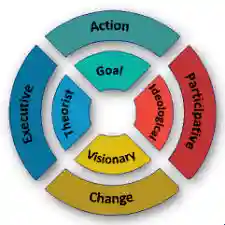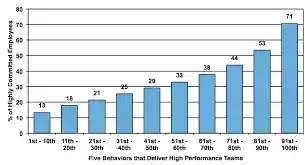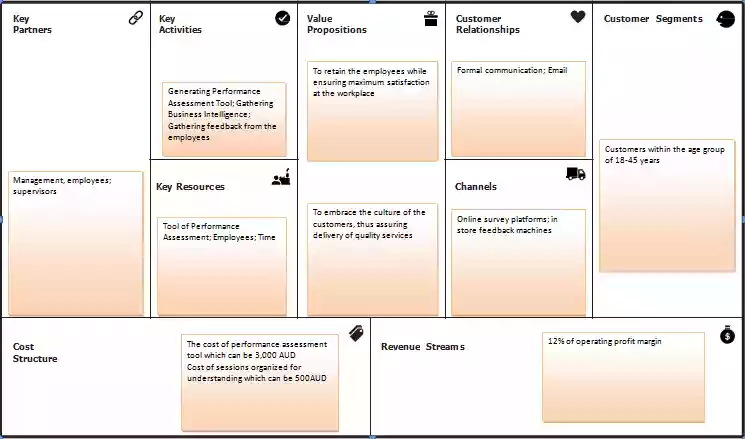Business Model Assignment On Organizational Design & Development
Question
Task: The objective of this individual assessment submission is to learn how to develop your own business idea, complemented by research and observational insights that detail why the need is compelling. Please submit a 1500-word business report of your idea, a detailed business model (BM) canvas, discussion of the interrelationships among the BM components that are essential to success, critical risks and assumptions, and overall feasibility. The business model canvas must be discussed in the report and included as an appendix.
The assessment criteria are detailed below.
- Effective explanation of the customer/market problem that needs solving and/or the reason the innovation is required. (15%)
- Persuasive argument of the customer/client benefits to be generated by the idea (10%)
- Discussion of the proposed business model (15%)
- Identification and discussion of the key interrelationships in the BM that will support success of the idea (10%)
- Critical success factors to be managed during execution of the idea (15%)
- Identification of critical risks and assumptions (10%)
- Evaluation of the overall feasibility of the idea (15%)
- Quality of written submission, minimum 6 peer-reviewed journals, and APA referencing format (10%).
Learning Outcomes Assessed:
- Investigate cases of disruptive innovation in different business and social contexts by applying lean entrepreneurship principles
- Develop ideas using conceptualisation frameworks, innovation personas and horizon thinking in different business and social contexts
- Demonstrate an understanding of and apply the stages of the innovation process, including learn how to forecast the success and market diffusion of your innovation using business model design logic
Answer
Introduction
The present report on business model assignment is focusing on the concept of Idea generation which leads to an effective innovation for developing business model for the companies that can establish the structure for the employees, which can eventually help them in producing products and services for the customers in a profitable manner. A business model generally describes the rationale for the process of organizational creation that may capture and deliver the value within social; economic; cultural and similar other contexts. This process of business model modification and construction is also known as business model innovation and forms the part of business strategy as well. Thus, the present study deals with identification of the problem within the retail sector and generation of ideas for solving the problem, which eventually leads to Business Model Development.
Explanation of customer/market problem that needs solving along with the reason for innovation
As per the present study, it highlights entrepreneurial problem of retail sectors. The problem is mainly concerned with leadership and management of the particular sector, which generally lies within the hands of company’s owners. According to Breuer et al., (2018), many people are known to be great entrepreneurs who are able to start their companies through any idea however, the similar people at times, are not found to be ready for handling the issues related to management. The owners of the company face these issues while their company tends to grow larger and mature. Nevertheless, without any prior experience or rather due to incompetence, most of the wholesaler retailers or storeowners are the reason for the failure of their companies. Hence, through experience, many business owners in this kind of situation try to avoid big challenges before the situation gets out of their hands. The main problem that is concerned with the retail market is that most of the managers and leaders in the recent days are found to make use of Authoritative leadership style for the employees, which comprises of many disadvantages for the organisations and businesses as well. Thus, for avoiding the risks of the businesses, the particular style needs to be mitigated through the idea of undertaking performance assessment tool that can help in changing the management and leadership styles from time to time based on the situational analysis such as Situational Leadership Style and Transformational Leadership Style.
Persuasive argument for client/customer benefits to be generated through the idea
As per the above discussion within this business model assignment, authoritative leadership style is not suitable in this modern era for the retail organizations and its businesses as well. Thus, incorporation of the particular leadership styles such as transformational leadership and situational leadership style. The transformational leaders are generally good in building culture and providing individual support with intellectual stimulation (Keane, Cormican & Sheahan, 2018). These leaders are also responsible for encouraging positive behaviours; holding expectations for higher performance of the employees along with building vision for the organizations. In the case of situational leadership style, this refers to a leader who can modify their own style according to the demand of the situation. This style is refers to as customer centric and also helps in setting goals for the employees as these leaders are both supportive and directive for their employees while execution of any task. The situational leaders are not found to change their own approach for taking advantage of a particular situation rather, they adopt a specific way by considering certain factors like maturity level of the employees; structure and culture of the organization and similar others (Heikkilä, Bouwman & Heikkilä, 2018). Thus, in the case of transformational leadership style, these leaders and managers consists of the ability to retain their consumers through their effective interaction for the long run. Hence, transformational leadership style can be much more suitable for the organizations rather than the other style.
Discussion for proposed business model
As per the structure of the proposed business model, the key partners for execution of the idea regarding the innovation of leadership style has been identified as the employees; managers and supervisors of retail sector organizations as, they are the people who can deal with the respective tool of performance assessment (Keane, Cormican & Sheahan, 2018). However, the key activities are termed to be the generation of the respective performance assessment tool and collecting the feedback from the employees as well (Broome, Bowersox & Relf, 2018). On the other hand, the key resources have been indicated as the tool along with the employees and time. Nevertheless, the channels for maintaining customer relationships can be online survey platform for the customers and the feedback machines that are used by the retail organizations. However, the demographic segment related to the customers can be identified as the age group of 18- 45 years of age. Furthermore, the cost of the machine has been found as 3000 AUD along with 500 AUD per session that needs to be organised for understanding the technicality of the tool.
Identification and discussion for key interrelationships in BM for supporting the success of the idea
Interrelationships within the different components of the Business Model canvas ensure success of the innovative ideas and value propositions to be implemented by the organizations. The key partners of Business Model Canvas are known to represent the relationship within other businesses; non-consumer entities and governmental entities as well (Roman, Liu & Nyberg, 2018). On the other hand, the key activities are referred to as the business functions that need to be performed by the organizations for operating in a successful manner. Thus, these two aspects are interrelated within each other as they contribute for value propositions to be created for maintaining customer relationships and earning revenues. However, the channels and the aspect of customer relationships are also interrelated within each other as, the particular channels of online survey and in-store feedback machines can help the organizations to look after the requirements and viewpoints of the customers, which in turn can help in building a stronger relationship, and retain the customers as well.
How essential critical success factors discuss within this business model assignment?
Critical Success Factor is an element mandatorily used by the organisations in order to achieve their objectives and missions. However, if an organisation faces the issue of Authoritative Leadership, the start to follow certain success factor that is as follows;
Action orientation: The leader takes up action that leads by the example involved and focuses upon the task with a sense of immediacy and results in fruition (Voegtlin et al., 2019). The leader helps in the execution of business objectives and enhances the growth of the company.

Figure 1: Action Orientation
Source: (Voegtlin et al., 2019)
Team build ups: The leaders build up an effective team by establishing a relationship of trust, honesty and loyalty with the respective team members rather than terrifying them with the power of their position (Liao et al., 2019). Hence, the leaders of the teams encourage the members to cooperate and coordinate with the work unit.
Demonstrating personal accountability and trust build up: this involves that the leaders should define the duties and responsibility to the employees by being clear about the company perspectives and describing the duties and expectations of the workplace. Thus, the leaders tend to keep promises and commitments to the team with accepting responsibility.

Figure 3: Demonstrating personal accountability and trust build up
Source: (Liao et al., 2019)
Influence: Here, the leader inspire, encourage and persuade the team members and taps the skills and knowledge of the group, influence the members to achieve results by drawing out commitment and generate enthusiasm.
Self confidence: The leaders take risk to accomplish the mission and have an assured sense of sensibility.
Agility and flexibility: the ability of a leader to be effective in complex and changing situation.
Communication: this helps in understanding, solving problems and building up a trustworthy relationship between the leaders and the team members.
Identification of critical risks and assumptions in this business model assignment
As per the Performance Assessment Tool used in the organisation, situations might arise when the employees are unable to give appropriate feedback for the functioning of the assessment tool, owing to some personal grudge with the leader or any other imminent departmental pressure, which might lead to incorrect assessment (Thompson & Glasø, 2018). Sometimes, the leaders might find it difficult to cope with the changing leadership styles, as suggested by the assessment tool, owing to lack of agility and flexibility, which might hamper the quality of their services and thus, the performance of the organization . Hence, with gap of communication between the leaders and the employees as well as the possibility of not using the tool efficiently remains as a risk to the organisation. The assumptions for the implementation of the tool is that the employees are able to render their feedback without any pressure from internal or external sources and the feedback delivered are free from any kind of bias.
Evaluation of the overall feasibility of the idea
Based on the views of Para-González, Jiménez-Jiménez & Martínez-Lorente, (2018), the idea of making use of Performance Assessment Tool for the retail organizations, there are certain factors that leads to the feasibility of the organizations for obtaining it. For instance, the five main feasibilities that can affect the organizational environment are mentioned below in this business model assignment:
Financial feasibility: In case of financial feasibility, the use of the particular tool can cost 3000 AUD, which may not be a big deal for the larger supermarkets. However, in the case of small retail stores, it may not be feasible in a financial way as, it can cost a lot not only for buying rather to maintain and use it as well.
Technical feasibility: In case of technical feasibility, the technicality of this particular tools need to be explained to the employees for which sessions are organised with a cost of 500 AUD. Thus, in the case of the large retail shops it is feasible to organise such a session to train their employees but on the other hand, the small markets cannot afford such a budget.
Operational feasibility: In case of operational feasibility, the operating of the tools is also a main concern of the organisation as like whether it could be operated by everyone or the new recruitments by again organising the session for them. It is not at all possible for the small retail shops and the maintenance and service of the tool by the specialist is also a problem for the small market but the large retail shops could act upon it (Ojasalo & Ojasalo, 2018).
Market feasibility: In this case, the cost of endorsing this tool in the market and judging its value among the customer is a concern arises in the organisation which sums to a high cost and hence, even if the large retail shop can afford the small retail market cannot.
Conclusion
From the above study provided in this business model assignment, it has been observed that any idea generated by an organisation leads to innovation by creating effective business model. However, discussion has been aroused about solving the customer/market problem, client/customer benefits generated through the idea, proposed business model, critical success factors and lastly the risks and feasibility of the ideas that can enhance the growth and development of an organisation.
Business model assignments are being prepared by our management assignment help experts from top universities which let us to provide you a reliable best assignment help service.
Reference List
Breuer, H., Fichter, K., Lüdeke-Freund, F., & Tiemann, I. (2018). Business model assignment Sustainability-oriented business model development: Principles, criteria, and tools. International Journal of Entrepreneurial Venturing, 10(2), 256-286.
Broome, M. E., Bowersox, D., & Relf, M. (2018). A new funding model for nursing education through business development initiatives. Journal of Professional Nursing, 34(2), 97-102.
Heikkilä, M., Bouwman, H., & Heikkilä, J. (2018). From strategic goals to business model innovation paths: an exploratory study. Journal of Small Business and Enterprise Development, 25(1), 107-128.
Keane, S. F., Cormican, K. T., & Sheahan, J. N. (2018). Comparing how entrepreneurs and managers represent the elements of the business model canvas. Journal of Business Venturing Insights, 9, 65-74.
Liao, S., Liu, Z., Fu, L., & Ye, P. (2019). Investigate the role of distributed leadership and strategic flexibility in fostering business model innovation. Chinese Management Studies, 13(1), 93-112.
Ojasalo, J., & Ojasalo, K. (2018). Service logic business model canvas. Journal of Research in Marketing and Entrepreneurship, 20(1), 70-98.
Para-González, L., Jiménez-Jiménez, D., & Martínez-Lorente, A. R. (2018). Exploring the mediating effects between transformational leadership and organizational performance. Employee Relations, 40(2), 412-432.
Roman, M., Liu, J., & Nyberg, T. (2018). Advancing the open science movement through sustainable business model development. Industry and Higher Education, 32(4), 226-234.
Thompson, G., & Glasø, L. (2018). Situational leadership theory: a test from a leader-follower congruence approach. Leadership & Organization Development Journal, 39(5), 574-591.
Voegtlin, C., Frisch, C., Walther, A., & Schwab, P. (2019). Business model assignment Theoretical Development and Empirical Examination of a Three-Roles Model of Responsible Leadership. Journal of Business Ethics, 1-21.
Appendices
Appendix 1

Figure 3: The Business Model Canvas
Source: (Created by the author)
Get Top Quality Assignment Help and Score high grades. Download the Total Assignment help App from Google play store or Subscribe to totalassignmenthelp and receive the latest updates from the Academic fraternity in real time.












